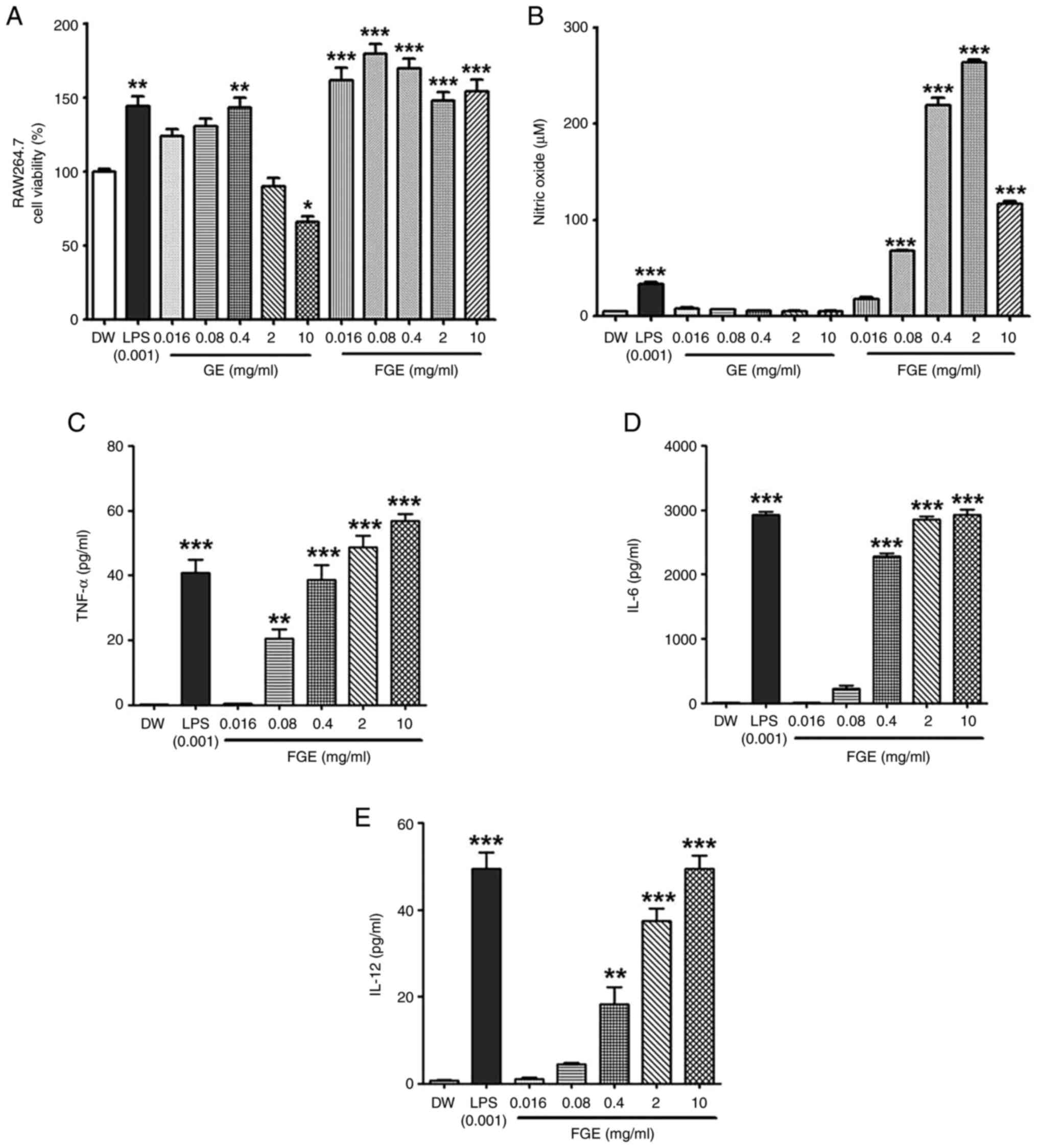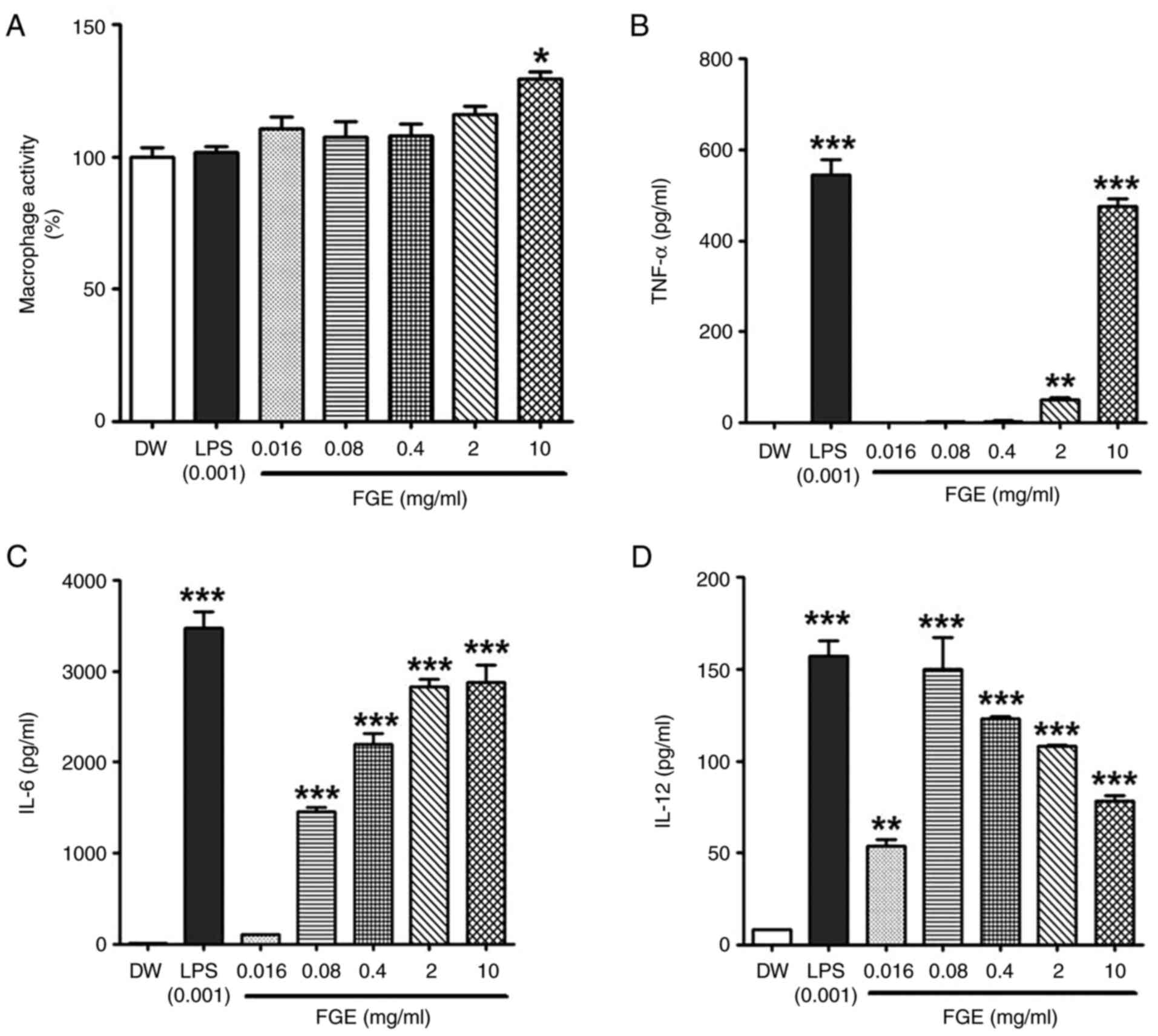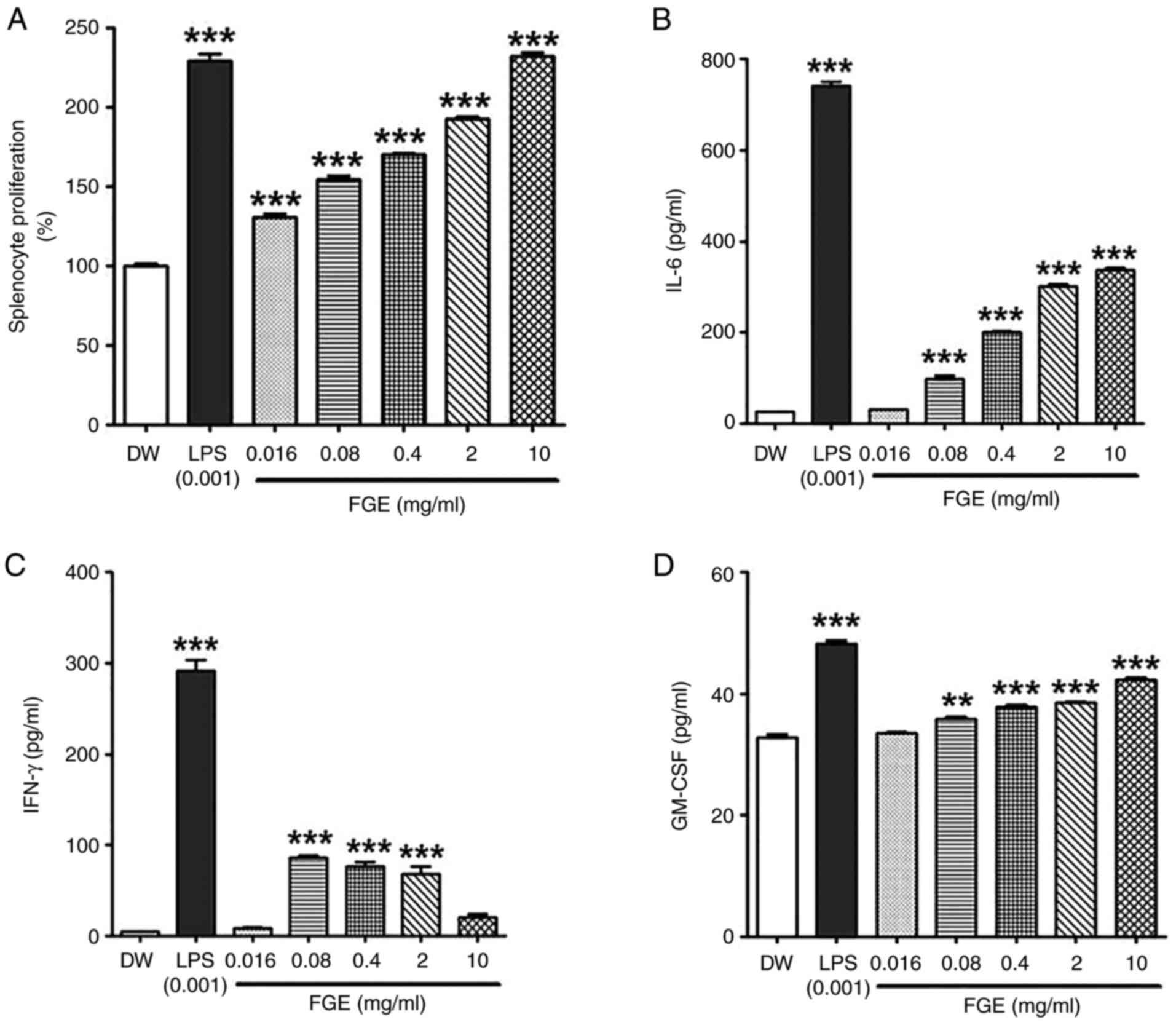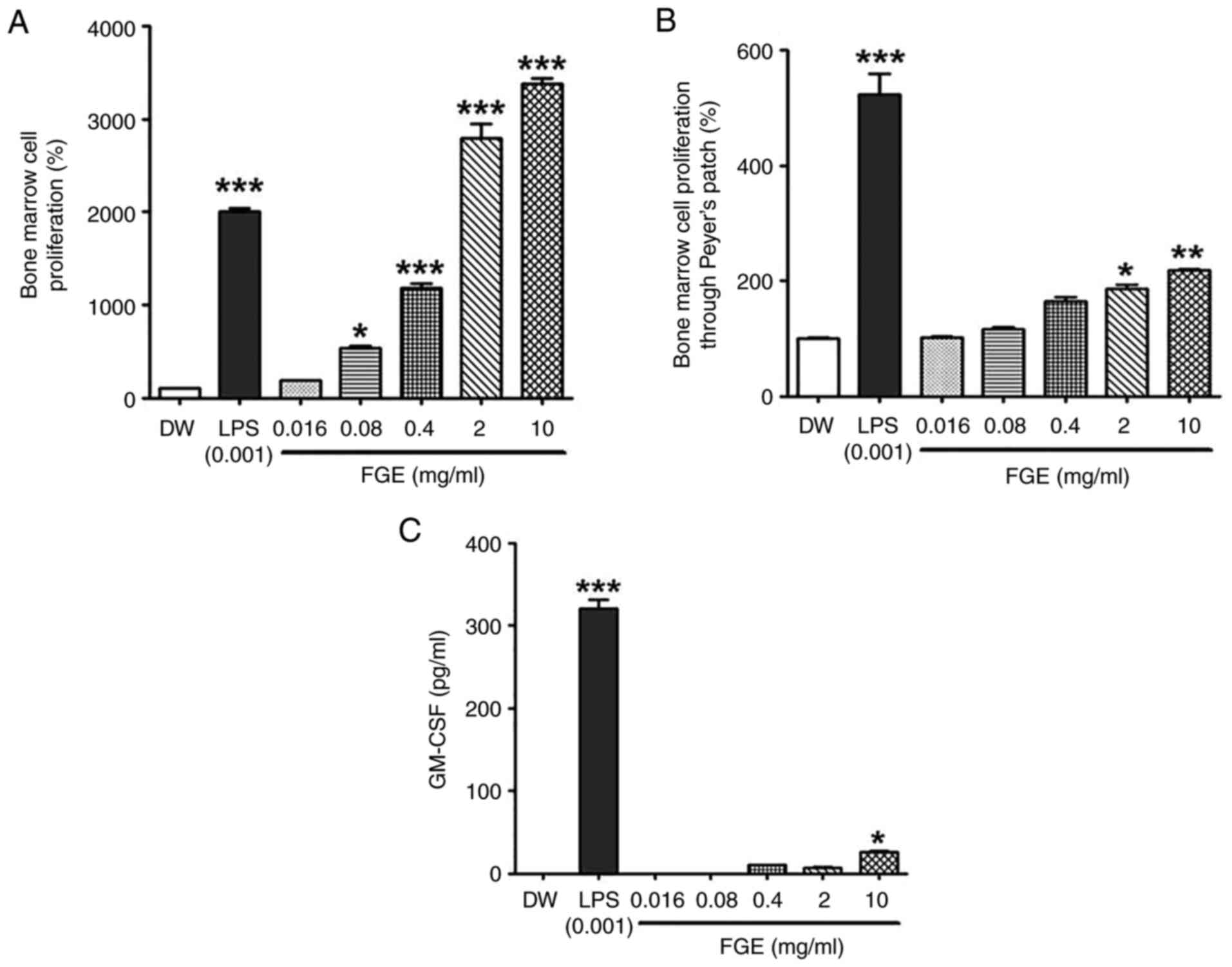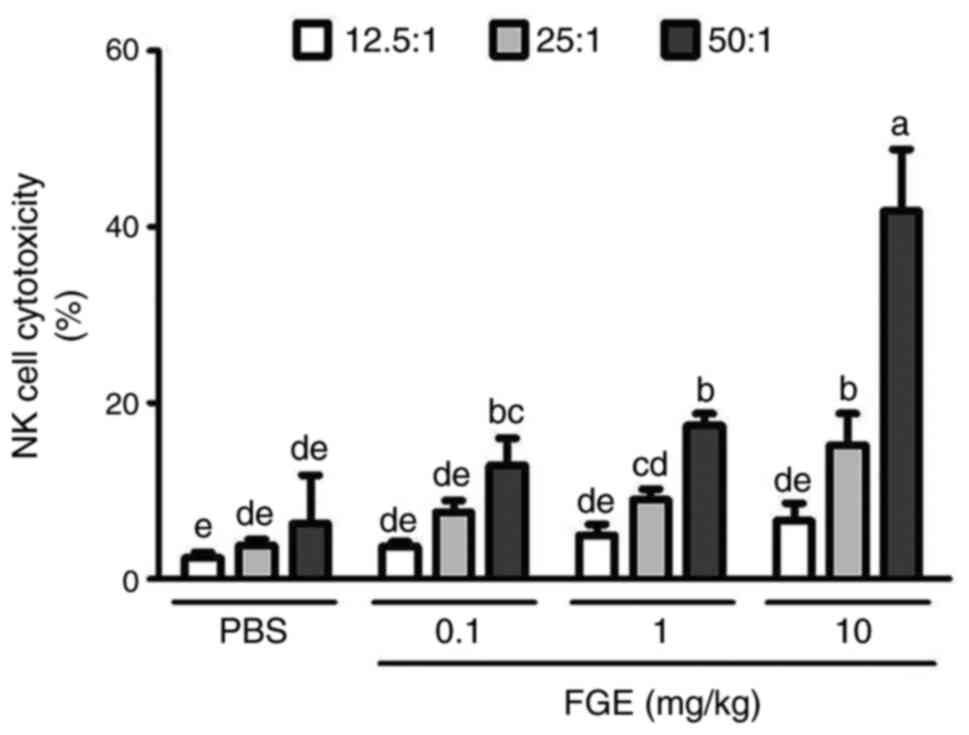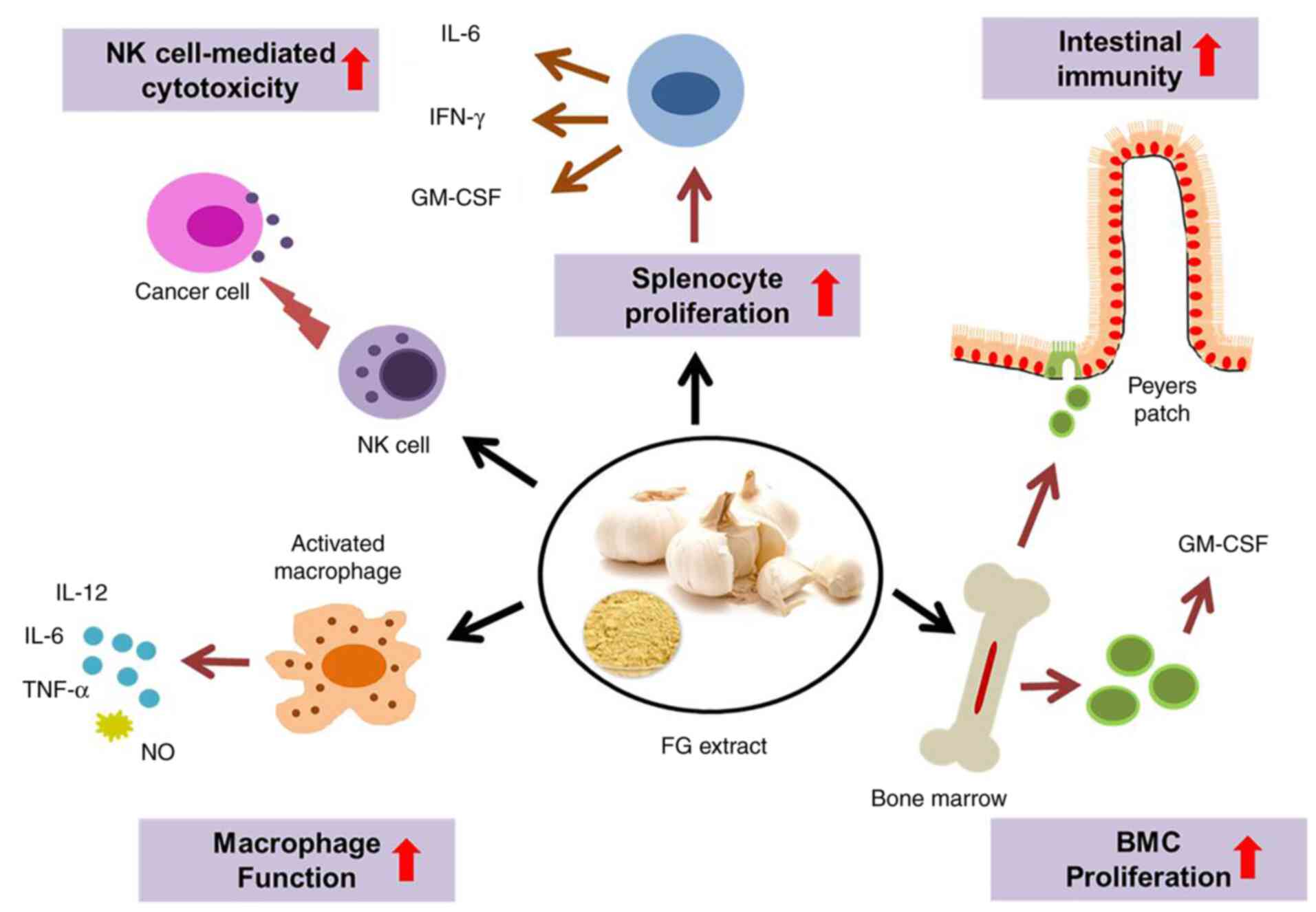|
1
|
Müller U, Vogel P, Alber G and Schaub GA:
The innate immune system of mammals and insects. Contrib Microbiol.
15:21–44. 2008.PubMed/NCBI View Article : Google Scholar
|
|
2
|
Warrington R, Watson W, Kim HL and
Antonetti FR: An introduction to immunology and immunopathology.
Allergy Asthma Clin Immunol. 7: (Suppl 1)(S1)2011.PubMed/NCBI View Article : Google Scholar
|
|
3
|
Blach-Olszewska Z and Leszek J: Mechanisms
of over-activated innate immune system regulation in autoimmune and
neurodegenerative disorders. Neuropsychiatr Dis Treat. 3:365–372.
2007.PubMed/NCBI
|
|
4
|
Patel DK, Dutta SD, Ganguly K, Cho SJ and
Lim KT: Mushroom-derived bioactive molecules as immunotherapeutic
agents: A review. Molecules. 26(1359)2021.PubMed/NCBI View Article : Google Scholar
|
|
5
|
Schepetkin IA and Quinn MT: Botanical
polysaccharides: Macrophage immunomodulation and therapeutic
potential. Int Immunopharmacol. 6:317–333. 2006.PubMed/NCBI View Article : Google Scholar
|
|
6
|
Camille N and Dealtry G: Regulation of
M1/M2 macrophage polarization by sutherlandia frutescens via NFkB
and MAPK signaling pathways. S Afr J Bot. 116:42–51. 2018.
|
|
7
|
Yeap SK, Omar AR, Ho WY, Beh BK, Ali AM
and Alitheen NB: Rhaphidophora korthalsii modulates peripheral
blood natural killer cell proliferation, cytokine secretion and
cytotoxicity. BMC Complement Altern. 13(145)2013.PubMed/NCBI View Article : Google Scholar
|
|
8
|
Wu D, Lewis ED, Pae M and Meydani SN:
Nutritional modulation of immune function: Analysis of evidence,
mechanisms, and clinical relevance. Front Immunol.
9(3160)2019.PubMed/NCBI View Article : Google Scholar
|
|
9
|
Yanishlieva NV, Marinova E and Pokorný J:
Natural antioxidants from herbs and spices. Eur J Lipid Sci
Technol. 108:776–793. 2006.
|
|
10
|
Londhe V, Gavasane AT, Nipate SS,
Bandawane DD and Chaudhari PD: Role of garlic (Allium
sativum) in various diseases: An overview. Angiogenesis.
12(13)2011.
|
|
11
|
Borrelli F, Capasso R and Izzo AA: Garlic
(Allium sativum L.): Adverse effects and drug interactions
in humans. Mol Nutr Food Res. 51:1386–1397. 2007.PubMed/NCBI View Article : Google Scholar
|
|
12
|
El-Saber Batiha G, Magdy Beshbishy A, G
Wasef L, Elewa YHA, A Al-Sagan A, Abd El-Hack ME, Taha AE, M
Abd-Elhakim Y and Prasad Devkota H: Chemical constituents and
pharmacological activities of garlic (Allium sativum L.): A
review. Nutrients. 12(872)2020.PubMed/NCBI View Article : Google Scholar
|
|
13
|
Mikaili P, Maadirad S, Moloudizargari M,
Aghajanshakeri S and Sarahroodi S: Therapeutic uses and
pharmacological properties of garlic, shallot, and their
biologically active compounds. Iran J Basic Med Sci. 16:1031–1048.
2013.PubMed/NCBI
|
|
14
|
Sung J, Harfouche Y, De La Cruz M, Zamora
MP, Liu Y, Rego JA and Buckley NE: Garlic (Allium sativum)
stimulates lipopolysaccharide-induced tumor necrosis factor-alpha
production from J774A.1 murine macrophages. Phytother Res.
29:288–294. 2015.PubMed/NCBI View
Article : Google Scholar
|
|
15
|
Arreola R, Quintero-Fabián S, López-Roa
RI, Flores-Gutiérrez EO, Reyes-Grajeda JP, Carrera-Quintanar L and
Ortuño-Sahagún D: Immunomodulation and anti-inflammatory effects of
garlic compounds. J Immunol. 2015(401630)2015.PubMed/NCBI View Article : Google Scholar
|
|
16
|
Salman H, Bergman M, Bessler H, Punsky I
and Djaldetti M: Effect of a garlic derivative (alliin) on
peripheral blood cell immune responses. Int J Immunopharmacol.
21:589–597. 1999.PubMed/NCBI View Article : Google Scholar
|
|
17
|
Ichikawa M, Ide N and Ono K: Changes in
organosulfur compounds in garlic cloves during storage. J Agric
Food Chem. 54:4849–4854. 2006.PubMed/NCBI View Article : Google Scholar
|
|
18
|
Shang A, Cao SY, Xu XY, Gan RY, Tang GY,
Corke H, Mavumengwana V and Li HB: Bioactive compounds and
biological functions of garlic (Allium sativum L.). Foods.
8(246)2019.PubMed/NCBI View Article : Google Scholar
|
|
19
|
Daliri EBM, Kim SH, Park BJ, Kim HS, Kim
JM, Kim HS and Oh DH: Effects of different processing methods on
the antioxidant and immune stimulating abilities of garlic. Food
Sci Nutr. 7:1222–1229. 2019.PubMed/NCBI View
Article : Google Scholar
|
|
20
|
Najman K, Sadowska A and Hallmann E:
Influence of thermal processing on the bioactive, antioxidant, and
physicochemical properties of conventional and organic agriculture
black garlic (Allium sativum L.). Appl Sci.
10(8638)2020.
|
|
21
|
Venkatesh YP: Immunomodulatory attributes
of aged garlic extract and its components. Immunology, Elsevie,
pp203-224, 2018.
|
|
22
|
Ogawa K, Funaba M and Tsujimoto M:
Suppression of NF-kappaB and IRF-1-induced transcription of the
murine IL-12 p40 by transforming growth factor-beta Smad pathway in
macrophages. Mol Cell Biochem. 308:9–15. 2008.PubMed/NCBI View Article : Google Scholar
|
|
23
|
Kim BG, Song Y, Lee MG, Ku JM, Jin SJ,
Hong JW, Lee S and Kang H: Macrophages from mice administered rhus
verniciflua stokes extract show selective anti-inflammatory
activity. Nutrients. 10(1926)2018.PubMed/NCBI View Article : Google Scholar
|
|
24
|
Albert MJ, Raghupathy R, Khan I and
Azizieh FY: In vitro spleen cell cytokine responses of adult mice
immunized with a recombinant PorA [major outer membrane protein
(MOMP)] from campylobacter jejuni. Sci Rep. 9(12024)2019.PubMed/NCBI View Article : Google Scholar
|
|
25
|
Jung C, Hugot JP and Barreau F: Peyer's
patches: The immune sensors of the intestine. Int J Inflam.
2010(823710)2010.PubMed/NCBI View Article : Google Scholar
|
|
26
|
Ingelfinger F, De Feo D and Becher B:
GM-CSF: Master regulator of the T cell-phagocyte interface during
inflammation. Semin Immunol. 54(101518)2021.PubMed/NCBI View Article : Google Scholar
|
|
27
|
Lee HJ, Yoon DK, Lee NY and Lee CH: Effect
of aged and fermented garlic extracts as natural antioxidants on
lipid oxidation in pork patties. Food Sci Anim Resour. 39:610–622.
2019.PubMed/NCBI View Article : Google Scholar
|
|
28
|
Diskin C and Pålsson-McDermott EM:
Metabolic modulation in macrophage effector function. Front
Immunol. 9(270)2018.PubMed/NCBI View Article : Google Scholar
|
|
29
|
Xu W, Zhao M, Fu X, Hou J, Wang Y, Shi F
and Hu S: Molecular mechanisms underlying macrophage
immunomodulatory activity of Rubus chingii Hu polysaccharides. Int
J Biol Macromol. 185:907–916. 2021.PubMed/NCBI View Article : Google Scholar
|
|
30
|
Palmieri EM, McGinity C, Wink DA and
McVicar DW: Nitric oxide in macrophage immunometabolism: Hiding in
plain sight. Metabolites. 10(429)2020.PubMed/NCBI View Article : Google Scholar
|
|
31
|
Morihara N, Sumioka I, Moriguchi T, Uda N
and Kyo E: Aged garlic extract enhances production of nitric oxide.
Life Sci. 71:509–517. 2002.PubMed/NCBI View Article : Google Scholar
|
|
32
|
Das I, Khan NS and Sooranna SR: Potent
activation of nitric oxide synthase by garlic: A basis for its
therapeutic applications. Curr Med Res Opin. 13:257–263.
1995.PubMed/NCBI View Article : Google Scholar
|
|
33
|
Park BM, Cha SA, Kim HY, Kang DK, Yun K,
Chun H, Chae SW and Kim SH: Fermented garlic extract decreases
blood pressure through nitrite and sGC-cGMP-PKG pathway in
spontaneously hypertensive rats. J Funct Foods. 22:156–165.
2016.
|
|
34
|
Cruz C, Correa-Rotter R, Sánchez-González
DJ, Hernández-Pando R, Maldonado PD, Martínez-Martínez CM,
Medina-Campos ON, Tapia E, Aguilar D, Chirino YI and
Pedraza-Chaverri J: Renoprotective and antihypertensive effects of
S-allylcysteine in 5/6 nephrectomized rats. Am J Physiol Renal
Physiol. 293:F1691–F1698. 2007.PubMed/NCBI View Article : Google Scholar
|
|
35
|
Asdaq S and Inamdar M: Potential of garlic
and its active constituent, S-allyl cysteine, as antihypertensive
and cardioprotective in presence of captopril. Phytomedicine.
17:1016–1026. 2010.PubMed/NCBI View Article : Google Scholar
|
|
36
|
Takashima M, Kanamori Y, Kodera Y,
Morihara N and Tamura K: Aged garlic extract exerts
endothelium-dependent vasorelaxant effect on rat aorta by
increasing nitric oxide production. Phytomedicine. 24:56–61.
2017.PubMed/NCBI View Article : Google Scholar
|
|
37
|
Tümer C, Bilgin HM, Obay BD, Diken H,
Atmaca M and Kelle M: Effect of nitric oxide on phagocytic activity
of lipopolysaccharide-induced macrophages: Possible role of
exogenous L-arginine. Cell Biol Int. 31:565–569. 2007.PubMed/NCBI View Article : Google Scholar
|
|
38
|
Bronte V and Pittet MJ: The spleen in
local and systemic regulation of immunity. Immunity. 39:806–818.
2013.PubMed/NCBI View Article : Google Scholar
|
|
39
|
Arango Duque G and Descoteaux A:
Macrophage cytokines: Involvement in immunity and infectious
diseases. Front Immunol. 5(491)2014.PubMed/NCBI View Article : Google Scholar
|
|
40
|
Griffin G, Shenoi S and Hughes GC:
Hemophagocytic lymphohistiocytosis: An update on pathogenesis,
diagnosis, and therapy. Best Pract Res Clin Rheumatol.
34(101515)2020.PubMed/NCBI View Article : Google Scholar
|
|
41
|
Tanaka T, Narazaki M and Kishimoto T: IL-6
in inflammation, immunity, and disease. Cold Spring Harb Perspect
Biol. 6(a016295)2014.PubMed/NCBI View Article : Google Scholar
|
|
42
|
Johnson CB, Zhang J and Lucas D: The role
of the bone marrow microenvironment in the response to infection.
Front Immunol. 11(585402)2020.PubMed/NCBI View Article : Google Scholar
|
|
43
|
Hassan ZM, Yaraee R, Zare N, Ghazanfari T,
Sarraf Nejad AH and Nazori B: Immunomodulatory affect of R10
fraction of garlic extract on natural killer activity. Int
Immunopharmacol. 3:1483–1489. 2003.PubMed/NCBI View Article : Google Scholar
|
|
44
|
Kyo E, Uda N, Suzuki A, Kakimoto M,
Ushijima M, Kasuga S and Itakura Y: Immunomodulation and antitumor
activities of aged garlic extract. Phytomedicine. 5:259–267.
1998.PubMed/NCBI View Article : Google Scholar
|
|
45
|
Hashizume T, Togawa A, Nochi T, Igarashi
O, Kweon MN, Kiyono H and Yamamoto M: Peyer's patches are required
for intestinal immunoglobulin A responses to Salmonella spp. Infect
Immun. 76:927–934. 2008.PubMed/NCBI View Article : Google Scholar
|
|
46
|
Kim H, Kim HW, Yu KW and Suh HJ:
Polysaccharides fractionated from enzyme digests of Korean red
ginseng water extracts enhance the immunostimulatory activity. Int
J Biol Macromol. 121:913–920. 2019.PubMed/NCBI View Article : Google Scholar
|















